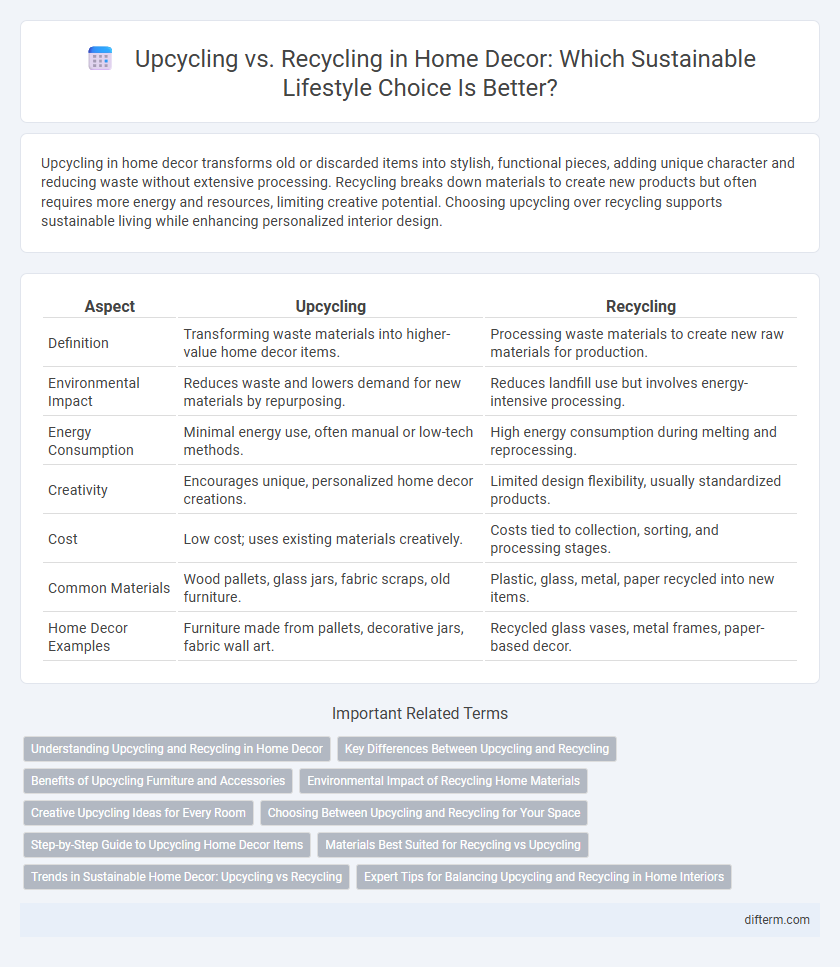Upcycling in home decor transforms old or discarded items into stylish, functional pieces, adding unique character and reducing waste without extensive processing. Recycling breaks down materials to create new products but often requires more energy and resources, limiting creative potential. Choosing upcycling over recycling supports sustainable living while enhancing personalized interior design.
Table of Comparison
| Aspect | Upcycling | Recycling |
|---|---|---|
| Definition | Transforming waste materials into higher-value home decor items. | Processing waste materials to create new raw materials for production. |
| Environmental Impact | Reduces waste and lowers demand for new materials by repurposing. | Reduces landfill use but involves energy-intensive processing. |
| Energy Consumption | Minimal energy use, often manual or low-tech methods. | High energy consumption during melting and reprocessing. |
| Creativity | Encourages unique, personalized home decor creations. | Limited design flexibility, usually standardized products. |
| Cost | Low cost; uses existing materials creatively. | Costs tied to collection, sorting, and processing stages. |
| Common Materials | Wood pallets, glass jars, fabric scraps, old furniture. | Plastic, glass, metal, paper recycled into new items. |
| Home Decor Examples | Furniture made from pallets, decorative jars, fabric wall art. | Recycled glass vases, metal frames, paper-based decor. |
Understanding Upcycling and Recycling in Home Decor
Upcycling in home decor involves creatively transforming old or discarded materials into new, stylish pieces, adding unique character and reducing waste. Recycling focuses on processing used materials to produce raw components for manufacturing new items, often requiring industrial facilities. Choosing upcycling promotes sustainability by minimizing environmental impact and encouraging personalized, eco-friendly home decor solutions.
Key Differences Between Upcycling and Recycling
Upcycling transforms old or discarded home decor items into new, unique pieces by enhancing their original value, while recycling breaks down materials to create raw inputs for entirely new products, often losing the original form in the process. Upcycling emphasizes creativity and individuality, preserving the item's structure, whereas recycling focuses on material recovery and sustainability through industrial processes. Choosing upcycling supports personalized home aesthetics and reduces waste without the energy-intensive steps involved in recycling.
Benefits of Upcycling Furniture and Accessories
Upcycling furniture and accessories in home decor reduces environmental waste by giving old items a new life, conserving resources and minimizing landfill contributions. It enhances creativity and personal expression through unique, customized pieces that reflect individual style while preserving the character of original materials. Upcycled decor often requires less energy and fewer chemicals than recycling processes, making it a sustainable and eco-friendly choice for conscious homeowners.
Environmental Impact of Recycling Home Materials
Recycling home materials reduces landfill waste and conserves natural resources by transforming used items into new products, cutting down the need for virgin raw materials and lowering greenhouse gas emissions. However, it often requires significant energy and water consumption during processing, which can offset some environmental benefits. Prioritizing materials with high recyclability and improving recycling technologies can enhance the overall environmental impact of recycling in home decor.
Creative Upcycling Ideas for Every Room
Creative upcycling ideas transform old furniture and materials into unique home decor pieces that add character and sustainability to every room. Repurposing wooden crates into stylish shelving, converting glass jars into decorative light fixtures, and turning fabric scraps into colorful throw pillows enhance both aesthetics and eco-friendliness. These innovative upcycling projects reduce waste while showcasing personal style in kitchens, living rooms, bedrooms, and bathrooms.
Choosing Between Upcycling and Recycling for Your Space
Upcycling transforms old or discarded materials into unique home decor pieces, adding character and reducing waste by extending the lifecycle of items. Recycling breaks down materials to create new products but often requires more energy and processing compared to upcycling's creative reuse approach. Choosing between upcycling and recycling depends on your style preferences, environmental goals, and the availability of materials suitable for each method.
Step-by-Step Guide to Upcycling Home Decor Items
Transforming old furniture into stylish home decor starts by thoroughly cleaning and sanding surfaces to prepare for painting or refinishing. Next, select eco-friendly paints, stains, or fabrics to refresh the item, enhancing its visual appeal while reducing waste. Finishing touches, such as new hardware or decorative elements, personalize the piece, extending its lifespan and minimizing landfill contributions compared to traditional recycling methods.
Materials Best Suited for Recycling vs Upcycling
Natural materials like wood, glass, and metal are best suited for recycling due to their ability to be broken down and reformed without significant loss of quality. Fabrics such as cotton and wool are ideal for upcycling, allowing creative reuse in home decor items like cushions, upholstery, and wall hangings. Plastic often benefits from recycling processes, while vintage textiles and furniture pieces lend themselves more effectively to upcycling projects that add unique character to living spaces.
Trends in Sustainable Home Decor: Upcycling vs Recycling
Upcycling in home decor transforms old furniture and materials into unique, stylish pieces, reflecting a growing trend toward personalized sustainability. Recycling focuses on processing waste materials into new raw materials, reducing landfill impact but often lacking the creative appeal of upcycled items. Consumers increasingly prefer upcycling for its ability to combine eco-conscious living with distinctive design elements in sustainable homes.
Expert Tips for Balancing Upcycling and Recycling in Home Interiors
Upcycling in home decor transforms old materials into unique, stylish pieces, enhancing personalization while reducing waste, whereas recycling focuses on processing materials to create new products, often losing original form. Experts recommend assessing the quality and condition of items to decide between upcycling for a creative touch or recycling for environmental efficiency. Incorporating both practices strategically maximizes sustainability and aesthetic appeal in home interiors.
Upcycling vs Recycling (in home decor) Infographic

 difterm.com
difterm.com